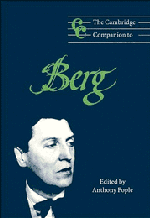Book contents
4 - Early works: tonality and beyond
from Part 2 - From song to opera
Published online by Cambridge University Press: 28 September 2011
Summary
First songs and instrumental music
Berg's dozen or so ‘official’ compositions, from the Piano Sonata Op. 1 through to the Violin Concerto he composed more than a quarter of a century later, are many times outnumbered by the songs he wrote between the ages of sixteen and twenty-three. Only eight of these were published during Berg's lifetime – the 1907 setting of Theodor Storm's ‘Schliesse mir die Augen beide’ and the selection of Seven Early Songs that Berg revised and orchestrated in 1928 – though one more was made available by Willi Reich shortly after the composer's death. The publication of two volumes of Jugendlieder in 1985 changed the picture entirely: it meant that roughly two-thirds of the approximately eighty-five early songs were available in published form; within a short while the same could be said of a significant proportion of the piano music Berg wrote in his early twenties. Between them, and almost exclusively, these two genres - solo song and piano music – carried him from his first teenage efforts as a composer through to atonality in the manner of Schoenberg.
One of the most striking features of this development is the disparity of Berg's achievement in the two genres. In a famous and characteristic letter written in 1910, Schoenberg described the situation without mercy:
Alban Berg … is an extraordinarily gifted composer. But the state he was in when he came to me was such that his imagination apparently could not work on anything but Lieder. Even the piano accompaniments to them were song-like in style. He was absolutely incapable of writing an instrumental movement or inventing an instrumental theme. You can hardly imagine the lengths I went to in order to remove this defect in his talent.
- Type
- Chapter
- Information
- The Cambridge Companion to Berg , pp. 51 - 82Publisher: Cambridge University PressPrint publication year: 1997
- 2
- Cited by

